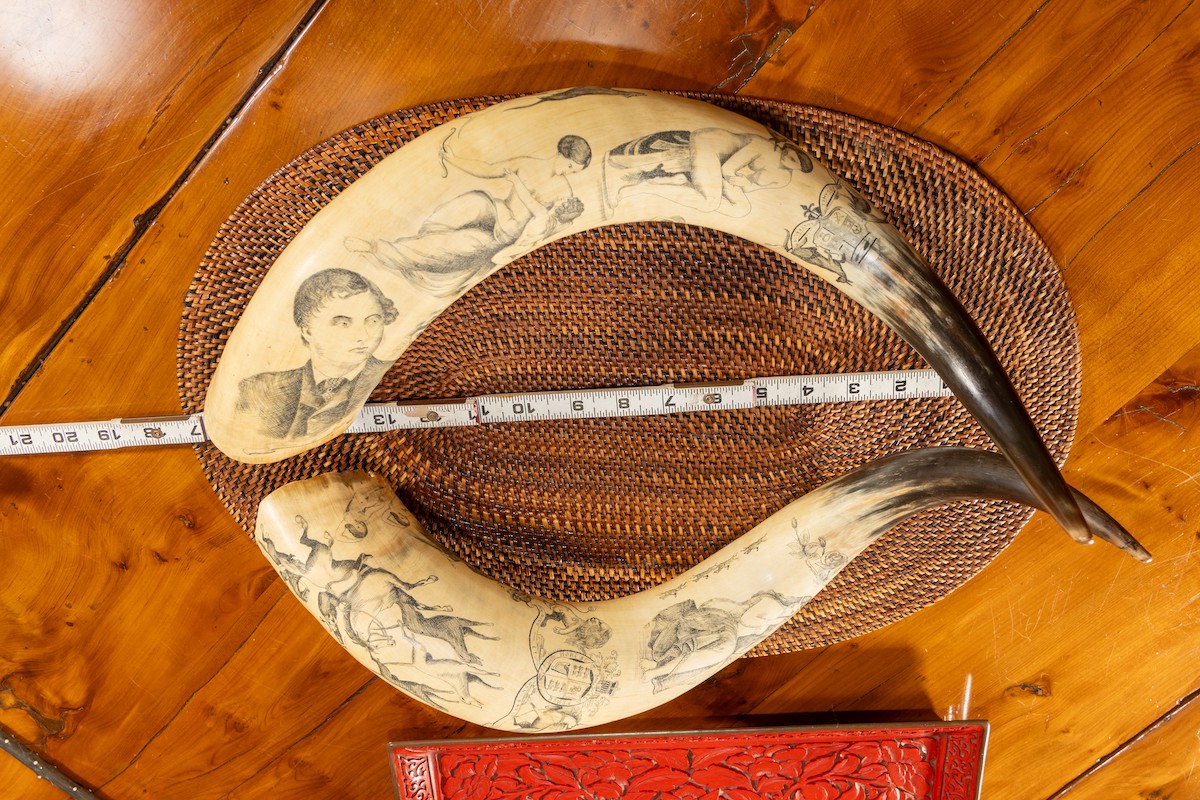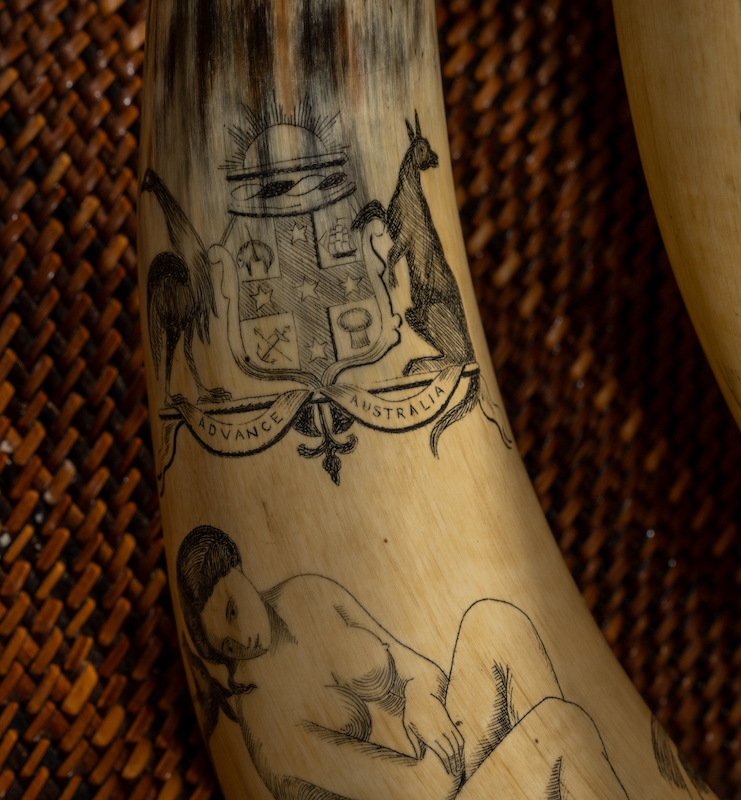Scrimshaw Horns

Forty years ago, in an antique shop, NH was intrigued by the somewhat sad face of the Prince of Wales engraved on a bullock’s horn, a pair of mated horns engraved with iconography of Australia in the scrimshaw technique. Engravings on horn, bone, or ivory, usually from a marine mammal, are classic material for scrimshaw, but in the 18th century scrimshaw as a folk art was used to decorate cow horns used for gunpowder. The firearms of the day, such as flintlock muskets, demanded dry powder. NH does not know WHICH Prince of Wales this sad face represents; these horns commemorate the visit of the Prince to Australia in 1868.
Later in the 19th century scrimshaw was a traditional folk art memorializing events and personages connected to military life. British seamen brought the tradition to the “colonies”; bored soldiers awaiting battles carved their horns around campfires, the designs were rubbed with grease and ash. Infact, the word scrimshaw is derived from the British slang word “scrimshanker,” an idler shirking his duty.

Prince Alfred, born 1844, was fourth child of Queen Victoria and Prince Albert, becoming the Duke of Edinburgh in 1866 until he succeeded his uncle as Duke of Saxe- Coburg in the German Empire. In his younger years he was known as a great sea admiral, having entered the Royal Navy at age 12, and appointed captain at 22, when he began a ‘round the world’ tour as the commander of the HMS Galatea (1867). He was the first Royal to visit Australia, spending five eventful months touring the country.
Australia went overboard to welcome the Prince. Similar to the horns that celebrate the noble visage of the Prince, Alfred’s face and figure were projected via magic lanterns onto notable buildings throughout the country. During his visit, many Australian buildings and institutions were named after him; The Royal Prince Alfred Hospital, Sydney; the Alfred Hospital in Melbourne; Prince Alfred College in Adelaide; Prince Alfred Park in Sydney; Prince Alfred Square in Parramatta; and the Royal Alfred Yacht Club.
This pair of horns honoring the Prince show the excitement of the people of Australia hosting their first Royal, but the visit was a disaster. Beginning at the State Library of Victoria in 1868, a massive medieval style torch-burning procession set fire to the library. During Alfred’s visit, sectarian conflicts arose between the Catholics and the Protestants of many major Australian cities: at a ceremony honoring William III – a protestant ancestor of the Prince – a riot broke out, shots were fired in the crowd, and a young boy was killed. A free banquet had been planned for 10,000 people, with food, drink, and speeches by the Prince: 70,000 people showed up and a mob scene ensued because the food and drink were insufficient. The crowd retaliated by stealing the tables, chairs, crockery, and cutlery. The Prince was whisked away. In Bendigo, a miniature model of the Prince’s ship Galatea manned by teenage boys in uniform tragically burned. A demonstration for the Prince by the Volunteer Fire Brigade went wrong, and the little Galatea ship model went up in flames with the boys. Elsewhere on the prince’s tour, the town of Bendingo had built a sister building – Alfred Hall – next door to its city hall. They planned to honor the Prince with a lavish fest. Alfred Hall burned to the ground 15 minutes before the scheduled ball, which was hastily moved next door to the old town hall. In Sydney, the Prince was the victim of an assassination attempt; the bullet ricocheted off the metal of his suspenders and thankfully did not reach any vital organs: he recovered quickly, nursed by Florence Nightingale, and requested clemency for his attacker – who was hung anyway.
I found a similar horn in the Australian War Museum, also a ceremonial scrimshaw horn. This was created in New South Wales between 1826-1832 when the Dorsetshire Regiment of Foot was posted to the colony of Australia. The horn was engraved for and by two British soldiers, one of whom served in Australia for six years supervising the convicts that labored on the Great North Road. As with NH’s horns, we see emblems of Australia and Britain, such as the English Rose, the Scottish Thistle, the Irish Shamrock, the Australian Banksia and Flannel Flower, an emu, snakes, a sailing ship, and a regimental badge.
Alfred was greatly admired for his many visits to far flung colonies of England: he was the first Royal to visit New Zealand in 1869, and the first European Prince to visit Japan in 1869. These horns are a remarkable memento of the royal zeal former colonies felt for the monarchy so very far away. I would put the value of this pair at $3,500-$4,000.





